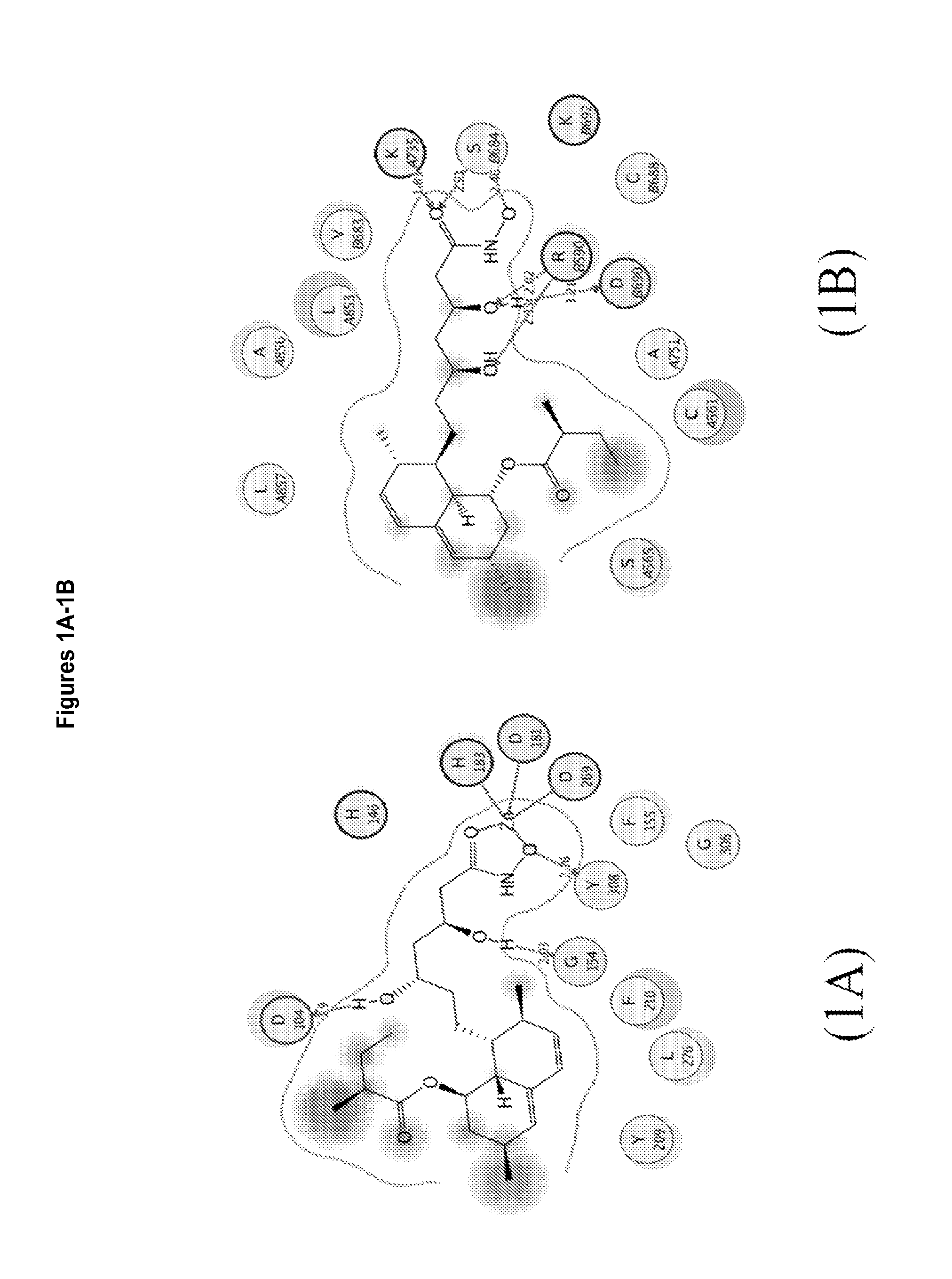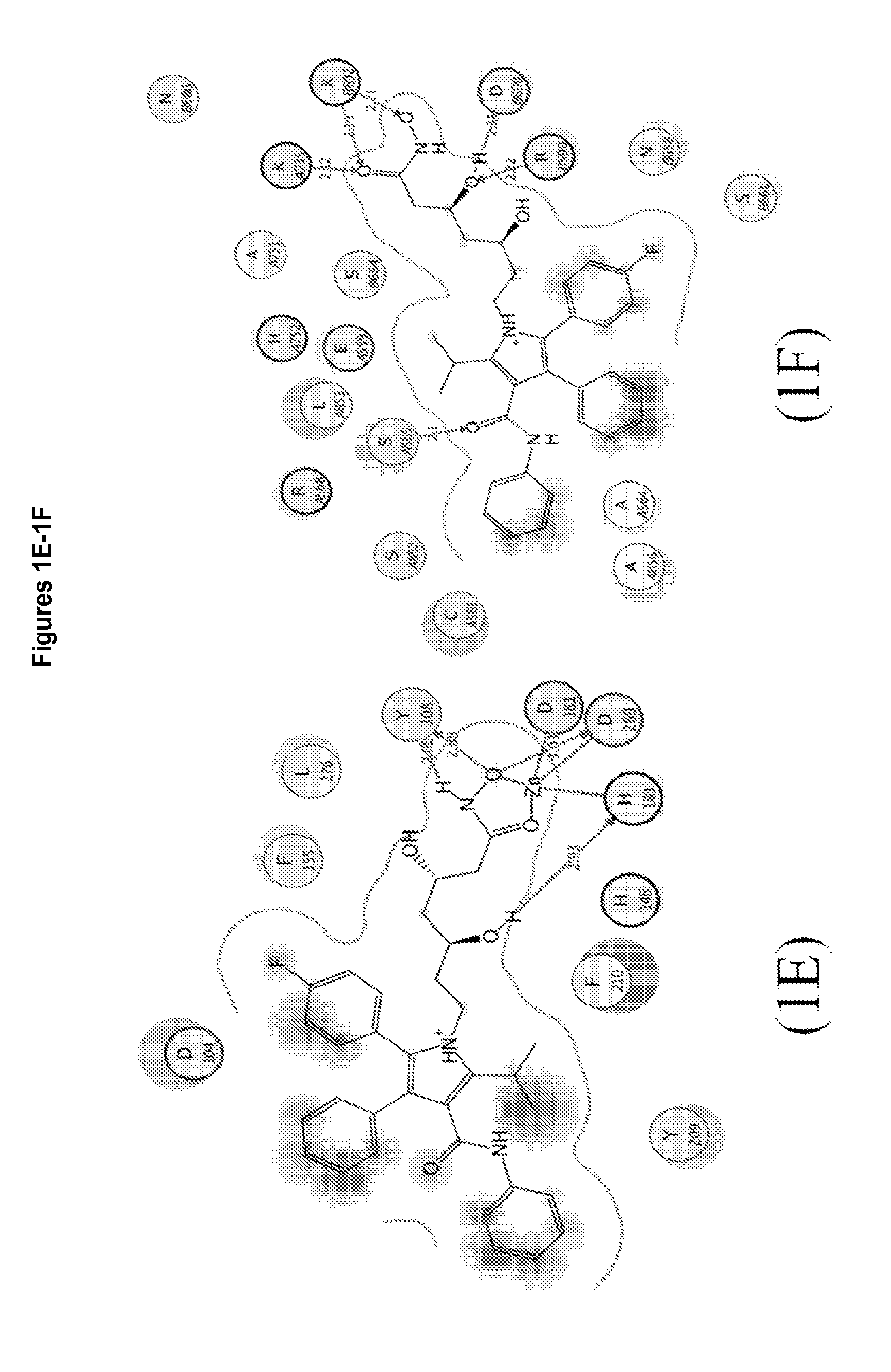3,5,n-trihydroxy-alkanamide and derivatives: method for making same and use thereof
a technology of n-trihydroxyalkanamide and derivatives, which is applied in the field of making the same and using thereof, and achieves the effects of not inhibiting the activity of hdac and/or hmgr, and inhibiting the growth of cancer cells
- Summary
- Abstract
- Description
- Claims
- Application Information
AI Technical Summary
Benefits of technology
Problems solved by technology
Method used
Image
Examples
example 1
Synthesis of Lova-HA ((3R,5R)-7-{(1S,2S,6R,8S,8aR)-Hexahydro-2,6-dimethyl-8-[2-methylbutyryloxy]naphthalenyl}-3,5-dihydroxy-N-hydroxyheptanamide) Instrumentation
[0384]Melting points were recorded on a Yanaco or Electrothermal MEL-TEMP 1101D apparatus in open capillaries and are not corrected. Optical rotations were measured on digital polarimeter of Japan JASCO Co. DIP-1000. [α]D values are given in units of 10−1 deg cm2 g−1 Infrared (IR) spectra were recorded on Nicolct Magna 550-11 or Thermo Nicolet 380 FT-IR spectrometers. UV-visible spectra were measured on a Perkin Elmer Lambda 35 spectrophotometer. Nuclear magnetic resonance (NMR) spectra were obtained on Bruker Advance-400 (400 MHz) spectrometer. Chemical shifts (6) are given in parts per million (ppm) relative to δH 7.24 / δC 77.0 (central line oft) for CHCl3 / CDCl3, δH4.80 for H2O / D2O, δH 3.31 / δC 48.2 for CD3OD, or δH 2.49 / δC 39.5 for DMSO-d6. The splitting patterns are reported as s (singlet), d (doublet), t (triplet), q (qua...
example 2
Synthesis of Sim va-HA ((3R,5R)-7-{(1S,2S,6R,8S,8aR)-Hexahydro-2,6-dimethyl-8-[2-dimethylbutyryloxy]naphthalenyl}-3,5-dihydroxy-N-hydroxyheptanamide
[0387]By a procedure similar to that for Lova-HA, simvastatin (100 mg, 0.24 mmol) was treated with MgBr2 (88 mg, 0.48 mmol), hydroxylamine hydrochloride (438 mg, 6.3 mmol), and sodium bicarbonate (160 mg, 1.9 mmol) in anhydrous THF / MeOH (7:3, 1 mL) at ambient temperature for 22 h to give Simva-HA (52 mg, 48%). The purity was 98% as shown by HPLC on an HC—C18 column (Agilent, 4.6×250 mm, 5 μm), tR=20.6 min (gradients of 30-80% aqueous CH3CN in 30 min). C25H41NO6; colorless oil; [α]24D=+194.1 (EtOAc, c=1.0); TLC (CH2Cl2 / MeOH (9:1)) Rf=0.33; IR νmax (neat) 3309, 3017, 2963, 2928, 2871, 1718, 1659, 1539, 1461, 1261, 1162, 1125, 1058, 975, 860 cm−1; 1H NMR (CDCl3, 400 MHz) δ 5.98 (1H, d, J=9.6 Hz), 5.76-5.79 (1H, m), 5.49 (1H, br s), 5.44 (1H, br s), 4.22 (1H, br s), 3.77 (1H, br s), 2.22-2.44 (6H, m), 1.99 (1H, dd, J=13.2, 8.0 Hz), 1.85-1.89...
example 3
Synthesis of Atorva-HA ((3R,5R)-7-[2-(4-Fluoro-phenyl)-5-isopropyl-3-phenyl-4-phenylcarbamoyl pyrrol-1-yl]-3,5-dihydroxy-N-hydroxyheptanamide)
[0388]By a procedure similar to Lova-HA, atorvastatin (168 mg, 0.31 mmol, in the lactone form) was treated with MgBr2 (115 mg, 0.62 mmol), hydroxylamine hydrochloride (184 mg, 2.6 mmol), and sodium bicarbonate (209 mg, 2.5 mmol) in anhydrous THF / MeOH (7:3, 1 mL) at ambient temperature for 20 h to give Atorva-HA (91 mg, 51%). The purity was 95% as shown by HPLC analysis on an HC—C18 column (Agilent, 4.6×250 mm, 5 Gm), tR=14.8 min (gradients of 30-100% aqueous CH3CN in 30 min). C33H36FN3O5; colorless oil; [α]26D=−1.3 (EtOAc, c=1.0); TLC (CH2Cl2 / MeOH (9:1)) Rf=0.33; IR νmax (neat) 3405, 3301, 3059, 2960, 2926, 1738, 1657, 1595, 1527, 1508, 1436, 1314, 1241, 1223, 1157, 1108, 1078, 1046, 843, 753, 692 cm−1; 1H NMR (DMSO-d6, 400 MHz) δ 10.31 (1H, br s), 9.77 (1H, br s), 8.68 (1H, br s), 7.50 (2H, d, J=7.6 Hz), 7.18-7.24 (6H, m), 7.07 (4H, br s), 6....
PUM
| Property | Measurement | Unit |
|---|---|---|
| Electrical resistance | aaaaa | aaaaa |
| Pharmaceutically acceptable | aaaaa | aaaaa |
| Stress optical coefficient | aaaaa | aaaaa |
Abstract
Description
Claims
Application Information
 Login to View More
Login to View More - R&D
- Intellectual Property
- Life Sciences
- Materials
- Tech Scout
- Unparalleled Data Quality
- Higher Quality Content
- 60% Fewer Hallucinations
Browse by: Latest US Patents, China's latest patents, Technical Efficacy Thesaurus, Application Domain, Technology Topic, Popular Technical Reports.
© 2025 PatSnap. All rights reserved.Legal|Privacy policy|Modern Slavery Act Transparency Statement|Sitemap|About US| Contact US: help@patsnap.com



